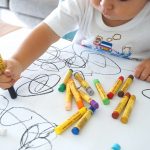I try to visualize as much as possible. This makes it much easier for me to remember things and also to recall them much later. I use sketches and graphic recording for workshops, meetings and other events to capture content and messages. Some people will say “Yes, you have to be able to draw well” but I would like to refute this and say that we all have what it takes to start working with visuals. After that it is of course practice practice practice practice.
All beginnings are hard
The hardest thing is the beginning, often you think much too complicated, the most important thing is to start simply and make the first scribbles. But you have to get away from a quality standard. Only the result counts. It does not have to be beautiful, it only has to serve its purpose. There are a few simple rules that should be observed.
- The purpose and the content counts. It doesn’t have to be a work of art, but must fulfill its purpose.
- While you are doing a sketch you are not being corrected. Of course I can take a step back digitally but in an analog sketch I work with what I have. Starting to erase or correct usually takes too much time so the speaker will run away.
- One or maximum two colors. Sketchnotes are sketches that transport a content. Too many colours usually make the sheets too confusing and confusing. So limit yourself to 2 colors you want to work with. Add a shadow at most. I prefer to work with black and turquoise, plus a light grey for depth and shadows.
- One page per drawing. A lecture should not exceed one page. It becomes confusing and confuses the viewer. On the other hand, we can of course divide the sheet and put several contents on one page.
- The contents are simply presented, preferably reduced to the essential. Avoid that you need too much time per element on your sketch. You don’t have that, because the presentation you want to capture is always going on.
These simple rules will certainly help you to create your first sketches quickly. The most important thing is that you have fun, don’t get too obsessed and enjoy the drawing.
I always enjoy watching children sketching. They are masters at simplifying content and are ideal role models for us. So a simple line drawing can tell a whole story that the child can certainly present to us. They are able to break things down to the essential and simply start drawing.

Digital or pen and paper
I think both have their charms. At most events I draw digitally because it is easier and I usually have the tablet with me anyway. A big plus is that you can share and send the content directly. But also drawing with pen and paper has its own charm. This is also a lot of fun. In the end everything belongs together for me and you want to take a little bit of everything with you.
But for beginners I would rather start analog and then practice, practice, practice. That is the most important thing. You just have to do it and find your own way. I always like to describe it as learning a new language. That’s exactly what it is in the end. You have to find your own way and develop your own vocabulary. A kind of dictionary where you have the drawings for the most important terms already at hand.
But most important – have fun!


